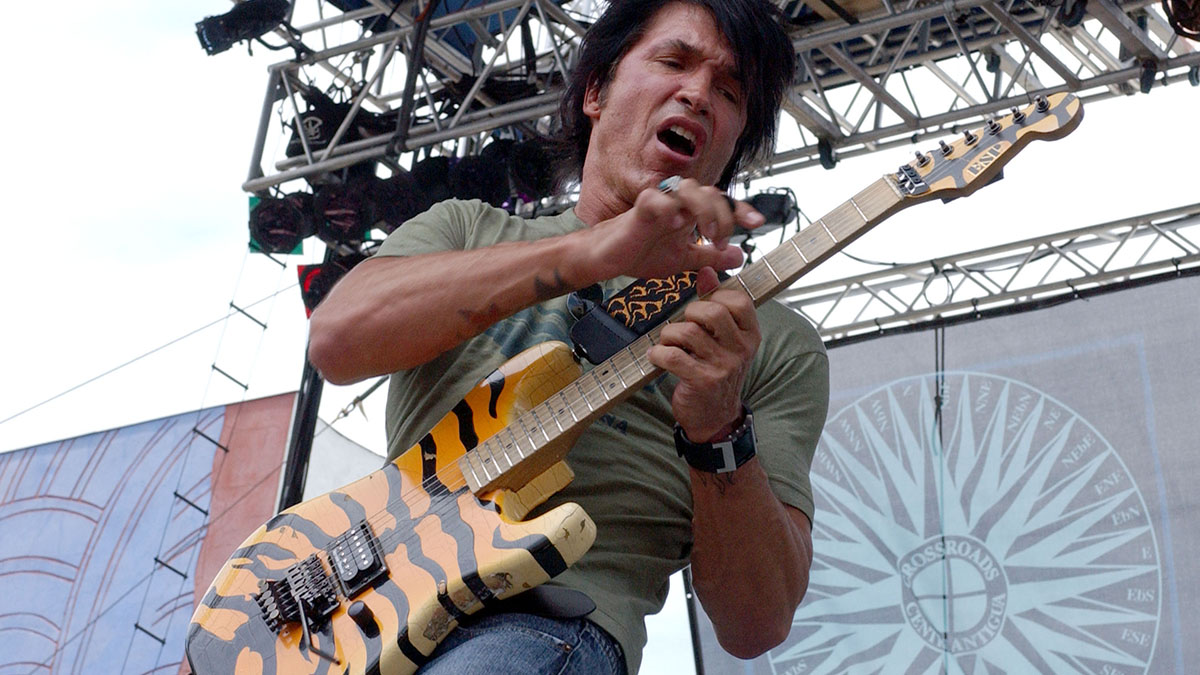Learn 5 George Lynch licks that demonstrate why the Dokken shredder really is Mr Scary
This shred lesson is so hot we've been keeping it under lock and key, until now...

George Lynch’s name is synonymous with rock guitar, initially from his time in Dokken, starting with Breaking the Chains in 1981 and following up with the classic Tooth and Nail in 1984 and Under Lock and Key in 1985.
It was the 1987 album Back For the Attack that would feature George’s calling card Mr Scary, an instrumental featuring many of his trademark techniques. In 1990, George unleashed Lynch Mob with the debut album Wicked Sensation. George’s style is inspired by the early technical rock players like Randy Rhoads and Eddie Van Halen, but with some Jimi Hendrix blues feel for good measure.
George tends to use the minor pentatonic scale at the core of his ideas, often with a creative twist. There is always an improvised, off-the-cuff feel to his playing and in this lesson we will look at some key Lynch approaches.
Our first example is a a typical two-string hammer-on lick, but moves through the scale positions in an interesting fashion. In the key of E minor, all of the open strings belong to the scale, so you could explore this idea across all six strings, all over the fretboard.
Example 2 is a a scary-sounding riff using palm muting and alternate picking. It’s based in F# Aeolian and uses the 2nd fret F# as a pedal, against which the other scale notes are played. The only limitations with this type of riff are your imagination and finger dexterity. Hone these two skills for the recipe for creative hard rock riffing.
Our 3rd example is a tapping lick based on a Lynch-style legato pattern which is essentially a fretting-hand trill, with a tapped note on each down beat. You can apply this technique to any triad, major, minor, diminished or augmented, and also pentatonic scales. This lick also features a tap slide, which entails tapping a note with your picking hand and sliding it up and down a semitone for a unique effect.
Our fourth lick is a typical Lynch lick, based around shape 1 of the blues scale, with some extra notes added. The major 3rd, 6th and 9th are all fair game to add to the scale, in order to add colour and musicality.
All the latest guitar news, interviews, lessons, reviews, deals and more, direct to your inbox!
Lick number five is a fast-paced flurry of legato notes played on the first and second strings. Lynch uses a very light touch when he plays, to allow his notes to flow freely and quickly. The following licks are quite challenging so, as always, start slowly and pay attention to accuracy, preferably using a metronome so that you can gradually build up the speed. Good luck!
Get the tone
Amp Settings: Gain 7, Bass 7, Middle 6, Treble 7, Reverb 2
George’s ESP signature guitars feature either a single coil at the neck with humbucker at the bridge, or single humbucker only.
For Lynch’s lead tone, use bridge pickup and plenty of tubey gain, perhaps with a boost or overdrive pedal in front of your amp. This allows the use of a very light touch in order to let the notes flow easily. Add a little reverb or delay for even more smoothness.
Example 1. Pentatonic hammer-ons
Use open strings and your first and second fingers to hammer on to these notes from E minor pentatonic scale, E-G-A-B-D. Pick each string with a downstroke, then use hammer-ons to complete the triplet feel up and down the neck.
Example 2. Palm-muted Aeolian lick
This riff is based in F# Aeolian mode (1-2-b3-4-5-b6-b7) played with the first, second and fourth fingers using alternate picking throughout. Palm mute the F# root note for a tight, consistent tone, but you can lessen the palm muting for the higher notes to add some dynamics.
Example 3. Tapped triads with slides
This lick is played with two hand tapping using minor triad arpeggios. For bars 1-3 use the same six-note pattern moved to different positions, but in bar 4 change the melody by using taps and slides; your picking hand’s second finger is an ideal tapping digit while holding the pick with the thumb and first finger.
Example 4. Major-minor hybrid lick
This lick uses a combination of E Mixolydian (1-2-3-4-5-6-b7) and E blues scale (1-2-b3-4-5-b5-b7) to create an interesting major and minor hybrid lick. The first bar has a triplet feel, whereas the second bar speeds up to 32nd-note phrasing.
Example 5. Nine-notes-per-beat legato lick
This legato lick is based in F# Phrygian mode (1-b2-b3-4-5-b6-b7) and ascends the fretboard in scale positions. The phrasing goes across the beat to create a natural, improvised effect, but it fits neatly into nine notes per beat. Enjoy your shredding!

Charlie Griffiths plays guitar in acclaimed prog-metal outfit Haken, and has a wealth of experience handling corporate and session gigs for genres as diverse as rock, heavy metal and pop. He has been a regular contributor to Total Guitar, Guitar Techniques and Guitar World for over fifteen years. His latest release is Tiktaalika - Gods of Pangaea which features stunning playing on, this time, 6-string guitars.
